June/July 2015
Icelandic Sagas
Summer too Hot? Come Chill out in Iceland!
We have a number of acquaintances who are traveling in Europe this summer, and all are complaining of the excessive heat. Have we got the cure for what ails them! We tell ‘em “Come on over to Iceland! It didn’t get over 54℉ during our entire six weeks stay, and one afternoon it dropped down to 31℉ at about 2:00 pm. That’ll cool you right down.” Ah, yes, where the North Sea meets the Arctic Ocean. And yes, the wind doth blow: sometimes it’ll blow you right over.
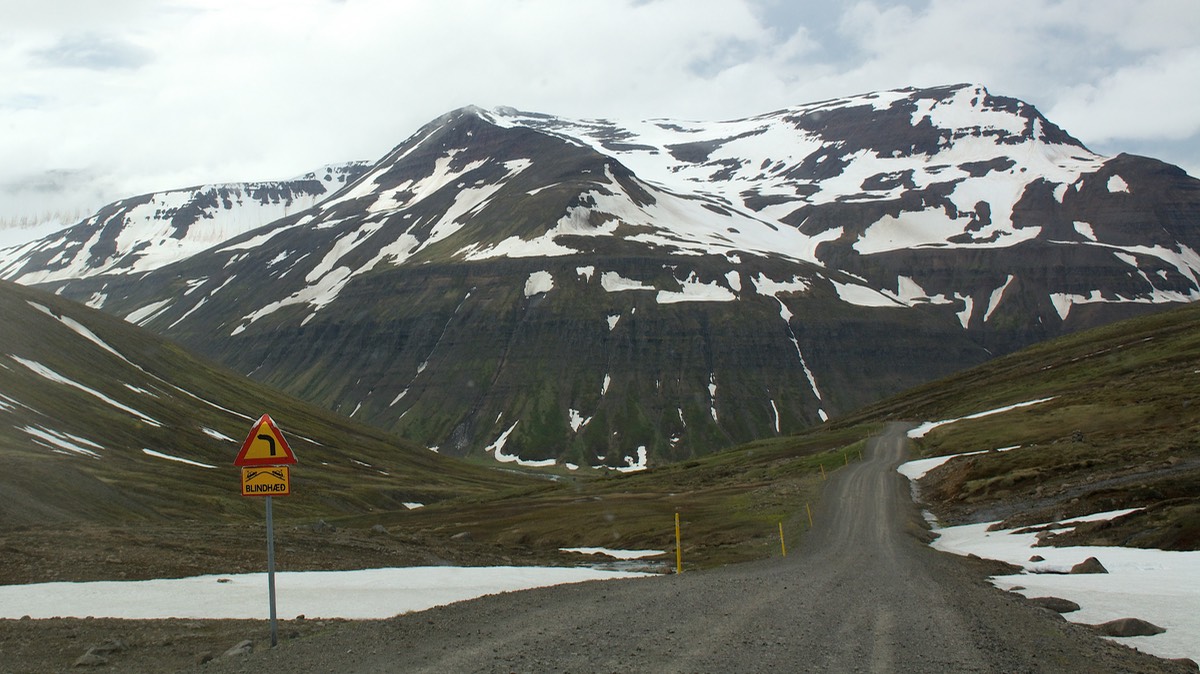
And that’s the story in a nutshell. If you are in full sun, and you are protected from the wind, it can be pure bliss. You can take your chair outside and sit there for hours, basking in the incredible warmth. But to be honest, that’s probably no more than 20% of the time here. Mostly it’s significantly cold (warm fuzzy sox 24 hours/day), rainy and damp, and don’t forget the wind.
But if you gotta be cold, there’s no finer place to sit and chill. Iceland has turned out to be a really great trip for us, complete with mountains covered with enormous ice caps, glaciers and pounding waterfalls. Then there are the volcanoes that ooze funny looking stuff, hot pots to warm up in, puffins like you’ve never gotten close to before, and solitude over almost 75% of the land area of the entire island.
Our dispatches are usually pretty chronological in nature, but for this report on Iceland we’ve decided on more of a topical format. So, here goes.
Our Long-Awaited Arrival
To get to Iceland, you either fly in to Reykjavik, the capital, which is located in the southwestern corner, or you take the ferry from Denmark, arriving on the eastern end. This is what we did, as Tiger does not like to fly and we would never have gone without him. So, mid-June, off we went. The voyage was pretty smooth and our cabin quite adequate, the food presentable, and the company about as you might expect. No drunks, not too many screaming children, plenty of places to sit and read/work on computers, and even some open decks to be enjoyed — if you could get out of the wind. There was an incredible number of very tall people aboard; we decided they were all Scandinavian.
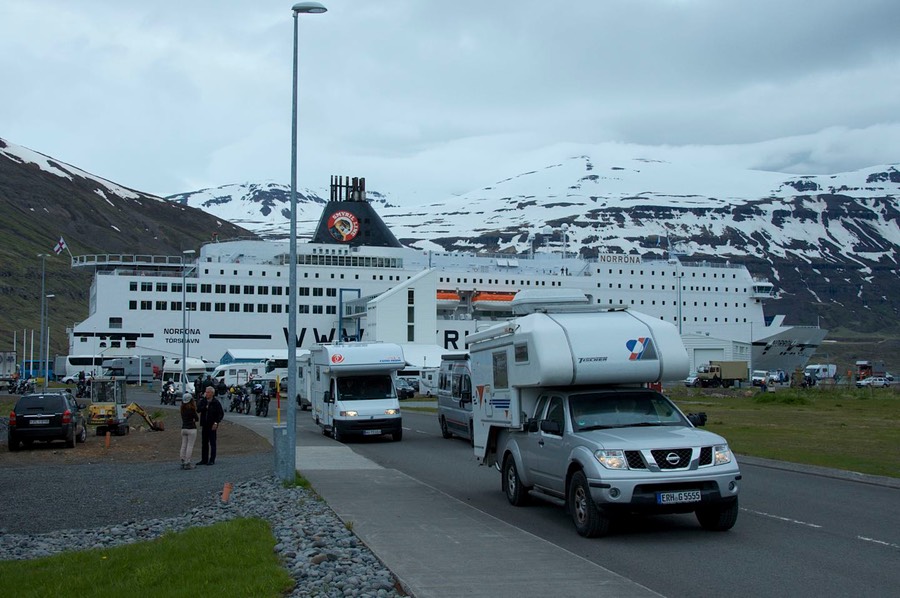
All the announcements were in three languages. The last one was English. This was okay, except that everyone else had already heard the message by the time we could finally understand what was being said, and they’d all started talking again, making it hard for us to hear the instructions. Oh, and about the time change. Denmark was on European summer time (GMT+1); the boat was on Faroe Islands time (GMT summer time - the same as London time); and Iceland is the same as London but stays on winter time (i.e., no Daylight Savings) so they are on GMT-1 in the summer, and GMT in the winter; such confusion. It was tricky, but we just went with the flow — ultimately, whadda we care? As long as we were out of our room on time in order to get ready to disembark, that was all that mattered.
After two nights aboard the M/S Norröna we pulled into the Icelandic port of Seyđisfjörđur, bored and ready for new adventures. There was the usual chaos getting off the boat. It always turns into a free-for-all, with those most anxious always the last off. One wrinkle was that the vehicles were packed in so tightly that lots of people couldn’t even get back into their cars and such, making even more mess than usual with folks standing around on the car decks. And of course at least one car alarm went off repeatedly; no surprise there. But eventually we all disembarked.
And there we were, back in Scandinavia to all intents and purposes. But whoa! Where were all the trees? Well, Iceland used to have lots of trees, back when it was first settled (roughly 860 or so), but within a hundred years they were pretty much long gone. Those Norsemen chopped them all down and used them for housing and warmth. After that all the timber had to be shipped in (literally) from the coast of Norway and Denmark. These days there are some clumps of smallish planted trees, mostly for windbreaks.
Iceland is a (relatively) round island with very crinkly edges. It’s shaped mostly like a bunch of volcanoes all lumped together; no surprise since that’s pretty much what it is. There’s a paved “ring road” that goes around the basic circle shape with dips and squiggles here and there. There are plenty of unpaved roads meandering up and down the many fjords and generally connecting the paved bits together, and then there are a few tracks (“F” roads) that cross parts of the interior. These are meant for rugged vehicles (4x4 and better), require fording rivers and more, and are only open for part of the year. If you open them too soon, we were told, they squish, become mud holes, and can become unusable for many years. Part of the problem is that it is necessary to allow the road to become unfrozen and the liquid underneath to flow away. In mid-July some of these roads were becoming available while others were still closed. Seems they had late heavy snows this spring (in early June). Practically speaking, Iceland appears to have two seasons — July and August…followed by winter.
The great preponderance of visitors stick to the ring road. They all want to drive the “F” roads but their car rental insurance won’t allow it, so they mostly stick with the plan. We will say, though, that the greatest single category of rental vehicles we saw was Toyota Landcruiser SUVs, pretty capable road cars.
For quite awhile we mostly stayed on the primary and secondary roads; we went up and over and down and around the fjords and the mountains on paved and unpaved roads, enjoying the lovely scenes off-shore. In mid-July many of the “F” roads opened, so we could explore some of them as well, and we’ll share those adventures with you. Some roads had not opened by the time we left at the end of July.
So now you know all about driving around Iceland. And speaking of same, we’d decided to make our circumnavigation of the island in a counter-clockwise direction. We had two sets of friends we were going to hook up with and they both were going the other way. We all figured this would make it easier to find someone down the road… and much to our surprise, it actually did work.
Puffins and Other Flying Objects
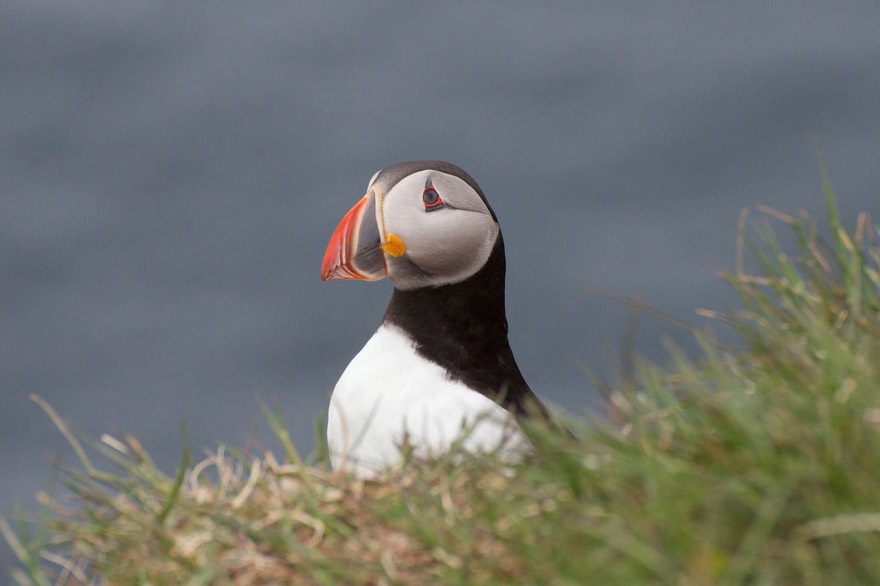
Getting off the ship we headed straight for known puffins. (If you’re going to Iceland, this is the one sure thing; there are guaranteed puffins… by the bucketful.) Turning north out of Seyđisfjörđur, we headed for the small town (there are only about three or four small cities in all of Iceland; everything else is either small town, small village or hamlet, or clump of 3-5 buildings, maybe with a fuel station) of Bakkegerđi and the nearby harbor. Puffins, along with lots of other birds, nest in the cliffs there. And we could get very close to them.
Puffins are easy to photograph because they settle in and aren’t afraid of you. They aren’t constantly flying away. They’ve come back from fishing, sit there with slimy little herrings in their beak looking quite pleased with themselves, and are happy to have their picture taken. And they sure are cute. Our cameras did quite well for us and we’ve got good pictures. There were folks there with “selfie sticks” who figured that was an advantage, but we felt well equipped. (We’re starting to see these sticks at various locations in our travels, mostly held by Asian tourists. Quite the deal.)
We had other good puffin encounters, probably the best being at the far western edge of the Westfjörds, at the Latrabjarg Cliffs. There, the puffins nest in the cliffs that you are standing on top of; this is very inviting and also slightly dangerous. You are advised to get down on your stomach and sort of creep forward until you get to the edge. Then you peek over and look down on the puffins. So cool! They are just a few feet away from you, right under the edge of the cliff, sitting there chatting with their neighbors, preening, sleeping, staring out to sea. It was neat. Way up close and personal. The reason for lying down is that the puffins nest in burrows they dig right under the grassy surface you would otherwise be standing on. This undermines the cliff edge, and the powers that be don’t want you tumbling off.
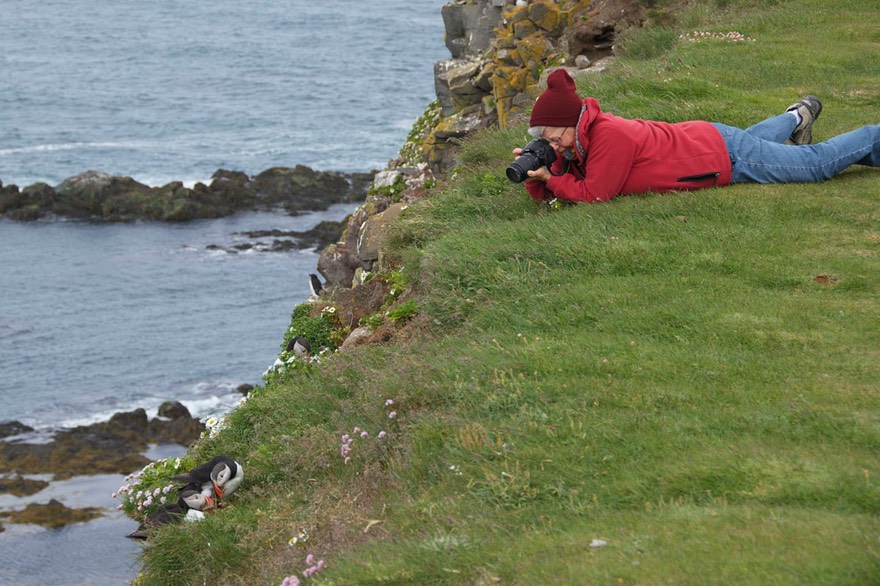
There are other flying objects in Iceland, many of them, some of which are less pleasant than the puffins. On the good side, there were tons of seagulls, ducks, geese and swans, along with many other birds with fancier names. We enjoyed them all, very much. We saw them all over the island; out in the water, tucked away in nests on clifftops, swimming in lagoons, swooping down to catch prey.
Ah yes, the “swooping down” part — the infamous Arctic terns of Iceland. They are very common, and quite obnoxious. I try and wave them away, scream at them, and take pictures of them. Finally I get back in the truck; they win. Think Hitchcock’s “The Birds.”
The following description comes from our friend Kate, who along with husband George, are spending much of their time hiking in the highland mountains. The description of their adventure with birds is of critters bigger than terns — Islandic Skuas. She says, “The birds are crazy here. Scary crazy. Stalk, swoop, squawk, attack. We must've looked like two hopeless mice, desperately stumbling across the snow, screaming, arms madly waving whilst two very unhappy and very large feathered creatures circled us like army drones. So in control. Hearts beating, muscles straining, "Woosh Woosh" (sound of their giant wings batting) , a blur of claws & beaks too close for comfort, more swearing, more stumbling, more arm flailing then, as quickly as it began, it was over. It was as though that's what they do, scare the sh*t out of stupid tourists then mosey off and casually dine on whatever unsuspecting critter they clawed to death! Bloody terrifying but a good laugh (I admit that I hid in Luigi for a full 24 hours afterwards!). So we now hike with our ski poles, i.e. we're armed and dangerous!” Luigi is their motorhome.
So? Who’s in charge out there? The birds of course!
About those Icelandic Names
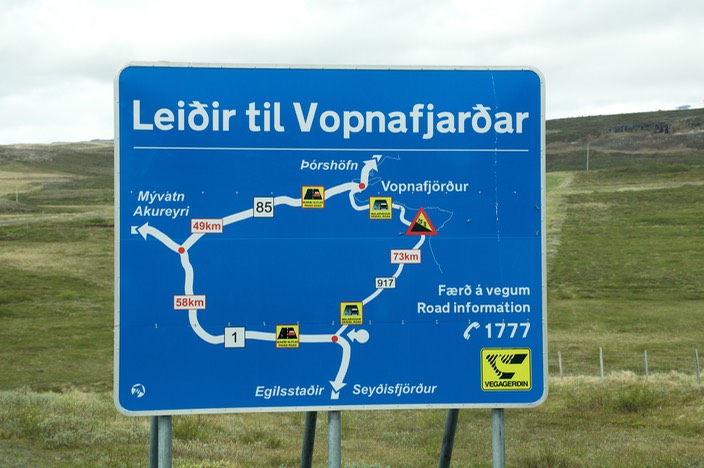
Do you have INF? Icelandic Name Fear? Worry not, you are in good company. The names don’t exactly come “trippingly off your tongue”, do they? Seyđisfjörđur, Egilsstađur, Stykkishólmur, Jökulsarlón, Djúpivogur, Snæfell, Ᵽingvellir — to say nothing of Drangsnes, Akureyri or the real tongue twisters like Kirkjubæjarklaustur — and those are just the names of towns. But there are clues. You can see the word fjörd in “fjörđur.” And “stađur” after “Egils” probably means the community originated as Egils’ farmstead. This works with peoples’ names, too. The old traditions here are very important. Lineage counts. Thuridur Einarsdottir, about whom you’ll hear more down the road, tells more about herself in her last name than you’ll find in many languages. And Icelanders don’t identify themselves by that last name either; apparently residents are listed in their town directory alphabetically by their first names.
Now I don’t want to carry this too far; I’m certain to go off down the wrong road immediately. But taking the long words apart does help; and it’s kind of fun. And no, we cannot pronounce them very well. Interestingly, it seems the locals don’t really say the whole word anyway; they tend to trail off and just hit a couple of letters once they’ve gotten halfway through. As we often do in countries with more difficult languages, we quickly adopted our usual shorthand of “the T-town” or “the S-town”; works for us.
Bulletin: Middle-Aged American Woman gets Be-Bogged
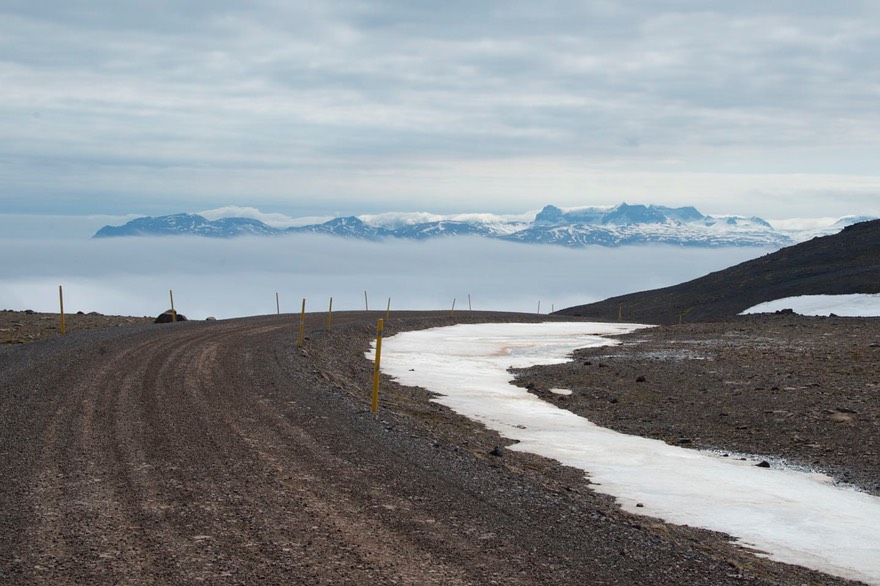
Following our usual M.O., we spent a lot of our Iceland time in the barren countryside off the beaten track. We have lots of adventures to share about when were were off-pavement (see discussion of F-roads), but also doing other perfectly sensible things where we could get into trouble… easily. Early on, we pulled off the road for lunch, and promptly sunk down in soft dirt. This should have been enough of a warning that Iceland’s crust is thin and somewhat precarious, but no, not enough warning for this intrepid couple. We were able to extricate ourselves from our roadside predicament, but that didn’t help little ol’ me a bit the next day.
We had come up to the top of a glorious pass, in the midst of lots of snow, and with lovely views of the fjord below. There was a large paved pull-off at the top and so we got out to take a look around. Should have been fine. Both of us walked out onto the (very firm feeling) tundra to get a better look, and took a bunch of pictures. As is typical, I wandered out further than Rick. Suddenly, I sank a foot and a half into the mud. Struggling to get out, I ended up with both feet firmly attached waaaay deep in the goo. I eventually got free, traded my formerly clean, nice walking shoes for sturdy hiking boots, and spent days trying to free the former of their accumulated yuck. This was an excellent illustration of why those F-roads were not yet open. The surface ground was sturdy and firm; it’s the water running underneath that was causing all the trouble.
Friends from OZ
We knew that two sets of friends from Australia would be traveling in Iceland at roughly the same time as we were coming over. We hoped to spend time with each, and as you know we circled in a counter-clockwise fashion with this in mind.
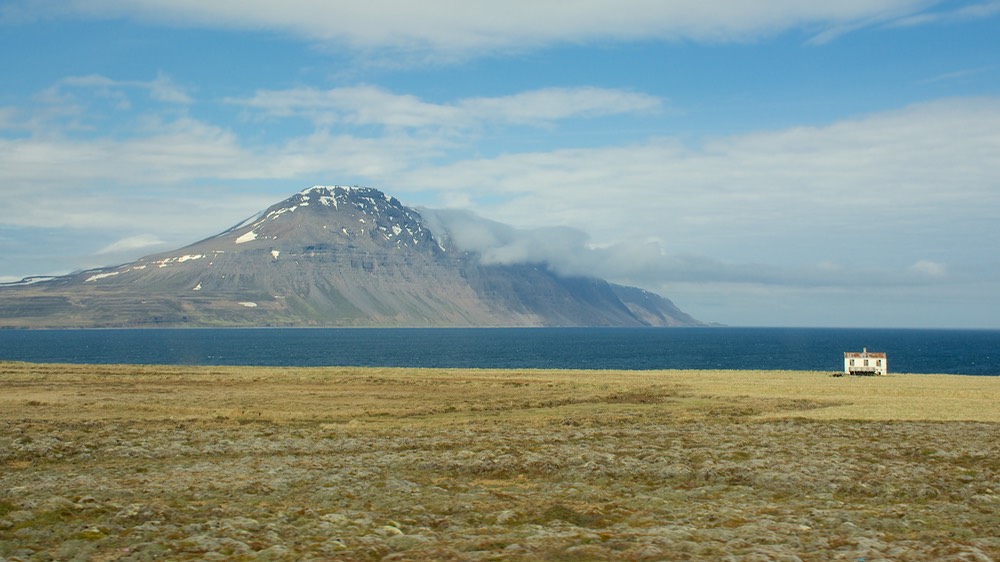
Kate and George had arrived here before us. Now you have to remember that they are young and quite nuts. Their idea of what to do was to head for the high ground, and hike all the trails they could manage. They’d set aside three months for this grand endeavour, and when we found them they seemed to be well on their way. They’d been thwarted by snow in several areas, had to wade through many cold streams, and were attacked by birds several times, but were really enjoying themselves. They will never run out of trails; Iceland is a hiking paradise. We know — we’ve already seen some of their pictures.
We found them at the eastern edge of the Westfjörds, the northwestern section of the country, and we spent several days together. We wandered the northwestern-most peninsula, taking as many roads as possible. At one point we went ahead and established a base for them to hike to, picked them up and thawed them out, then took them back to Luigi. It was fun.
After several days we parted company, with a plan for meeting up again further down the road, a couple of weeks later. In all, we managed to find each other a total of three different times. Each encounter was a new pleasure, as we shared our travels, made suggestions about what not to miss and places to overnight along the way, and commiserated about perennially cold feet and wet hiking boots (no, not ours; theirs of course!).
Our other friends, with whom we’d been corresponding for years but only just met in Arizona in May, had only recently arrived on the island, but were moving fast as they had less time available. Through the wonders of modern mobiles, we’d been able to stay in touch, sort of, when we had signal; from time to time, that is. We were out in the Westfjörds and they were coming up from the south.
Amazingly, we turned on the phone at one point, found they were not too far off, called and chatted, told them to sit tight, and within an hour or so were knocking on their door. It was terrific and cool and just plain neat. Rob and Nina are great folks, amazing Overlanders who have traveled from Vladivostok to Turkey via Iran (how about that!), and gracious and friendly. We sat and exchanged notes and ideas for future trips and laughed and carried on for quite awhile. Then, disappointingly, we all realised we had places we needed to get to, that the clock was ticking and we all were going to run out of Iceland-time, and said our good-bys. We will stay in touch and hope to see them again down the road sometime.
Fjords and Hot Pots and Glaciers — and Horses & Sheep as well
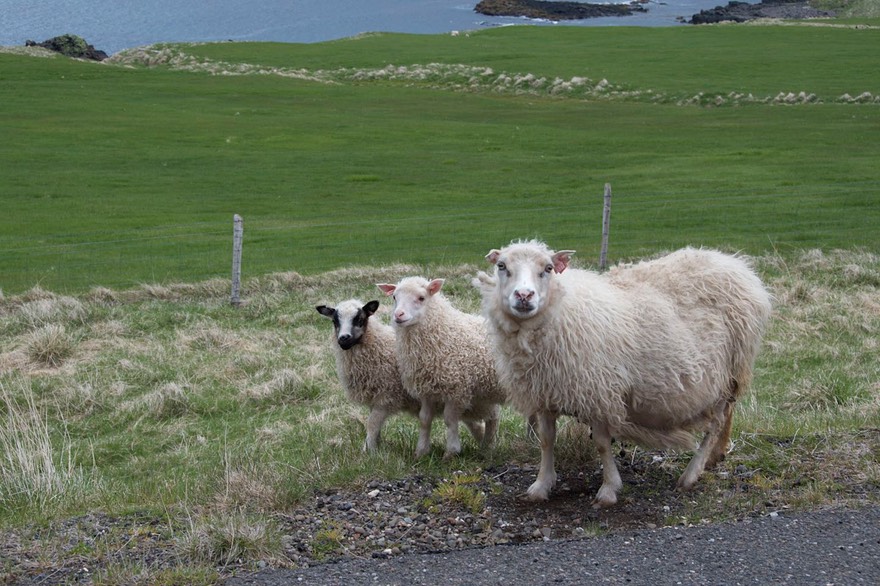
So why were we in Iceland? Oh yeah, to see the sights. And regardless of which way you go around, you will be heading for all of the above. We started in the northeast, which is the least visited quadrant, and for good reason. It is the most barren, with very little that is overtly attractive. But we found places to enjoy, small areas of flowers, waterfalls, and interesting rock formations; lots of open space and wide vistas.
And sheep, always sheep. Up here they grow them woolly and smart, and the mommas almost always have twins in tow. Smart, you ask? We think so; sheep are supposed to be stupid, but these are, at the least, very street-wise. We’ve not seen one get hit, not even close. They seem to be asleep, then suddenly mother must have murmured, because they all leap up and scuttle off. And they are everywhere. Not in herds, though; they are scattered all over, but never in large groups. We enjoyed them very much. And we now know what “Faster than two shakes of a lamb’s tail” means. Man do those puppies know how to shake their booties while they are nuzzled up to their mommas and nursing away!
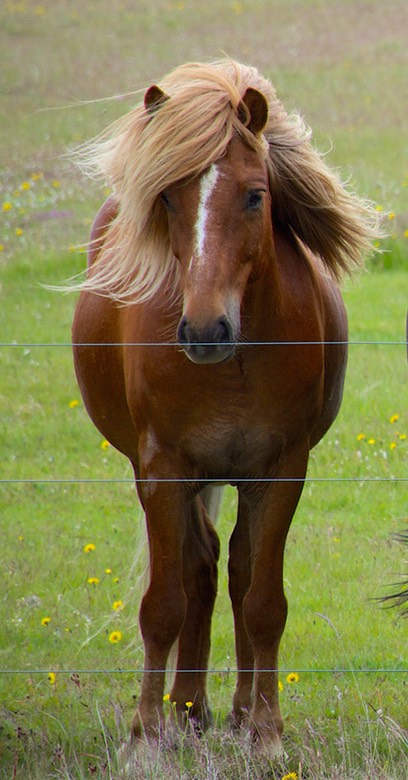
Probably ought to mention that the Icelandic horses are also around every corner. Now they are beautiful. Not overly large, but sturdy and well-built and very pretty to see out in the fields in their wonderful and varied colors and bushy-shaggy-flowing manes. All in a clump; quite social, and all wanting to be in the picture. They are happy to have Rick come up and commune with them, although the fencing appears to be electrified — they keep just enough distance. But we’ve never been more satisfied with our horse encounters. May they go on forever. When you get a chance to see them run, then their famous gait comes into play and they are glorious to behold. Really, really neat animals.
Glaciers are often in view, not just in the fjords, but throughout. Folks like to ski on them (even in the summer — we saw cars with skis on roof racks), or drive on them, or hike on them; we just like to look at them. On a clear day they glisten in the sun; on a misty day they are shrouded in fog.
We were able to get close, really close, to the glaciers coming off the enormous icecap that dominates the southern half of the island — the Vatnajökull. As you are driving along the southern ring road, fingers of the glacier come right out and grab at you. The water coming down into the ocean is icy cold, the air is damp and chilly even in the sun, and it’s a great experience. There are many places where you can hike in to get to the ice and snow, but we contented ourselves with stopping at Jökulsarlón, where a river filled with ice floes comes down to the sea. Now here you can get a really close look, and even go out in a boat to give them a poke if you like. We were happy to spend some time searching out the most beautiful, and looking at the birds nesting on them, and picking out our favorites to take pictures of. Very special.
About those hot pots visitors are always mentioning. Terrific, from our point of view. If you’re American, particularly if you’re from California, they are wooden and out in your backyard. Here, they are available as part of the public swimming pool complexes; you get into the pool for a bit, then go soak in the tub. (And you can follow that up with a sauna, or maybe an ice bath…) But, most delightfully, they are in isolated, secluded spots beside the road or up a hill or along a hike in the mountains or just wherever. One or two or more of varying temperatures. A concrete pot set among stones, or just the stones. Out under the stars, or in the rain, or on a brilliant sunny day. Tremendous. We grooved on ‘em. We’d given up our hot tub when we sold the house and hit the road; it had been a long dry spell. Cannot say too much about the pleasures of a hot pot.
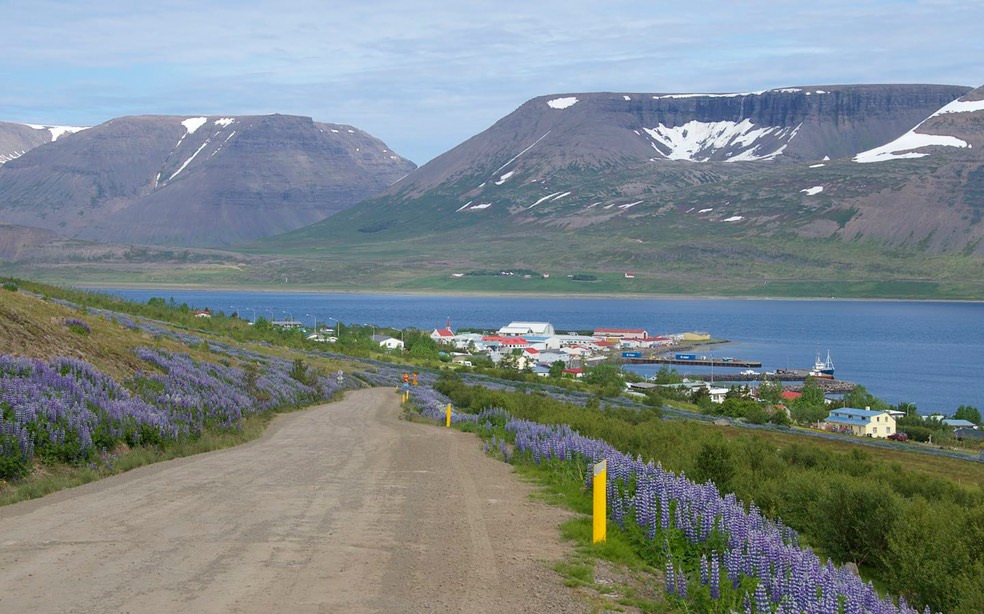
The Westfjörds cover the entire northwestern part of the island, and they are lovely and rugged. As you drive along there are snow-covered mountains, pretty inlets with tiny communities clustered where it’s most sheltered from the wind, and hillsides that are either green or barren but always dusted with wildflowers now that it’s summer.
As you come further south along the west coast, the landscape becomes more gentle. We’ve driven through lovely valleys with hay in the fields (the first harvesting was already completed by early July — is there a second one?), some dairy cattle now along with the sheep and horses, and larger farming communities.
Turning the corner and heading east, back towards our ferry ride to northern Denmark, we began to realize that our time in Iceland was getting a bit short and we would need to hustle if we wanted to see all that this great place had to offer. So Tiger took the bit between his teeth, and we scurried on.
We’ll be back to you soon with more adventures with R&K and the Intrepid Tiger in Iceland.
Click to see our two sets of photos from Iceland: Icelandic Sagas, or Land of the Sideways Sun